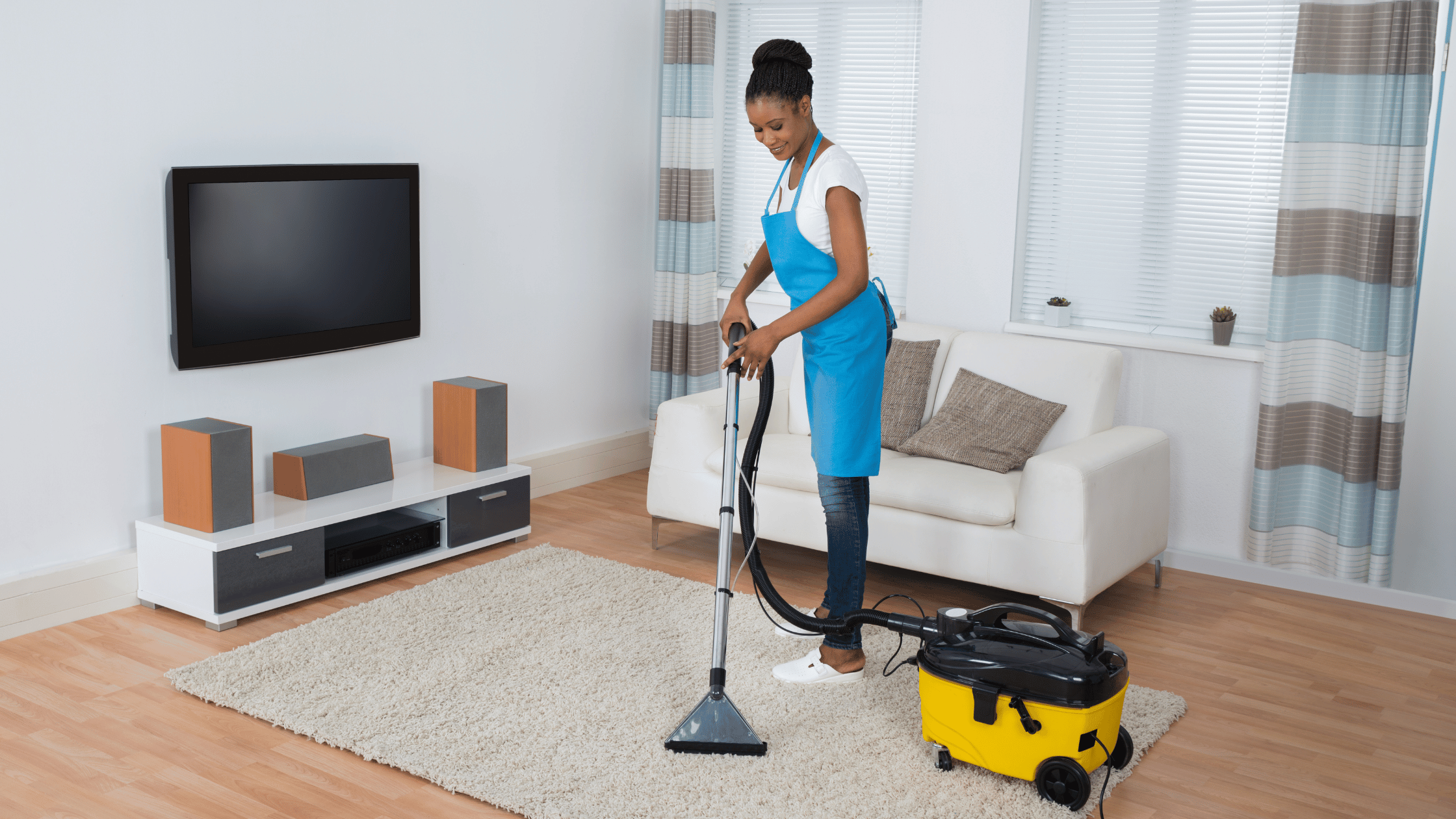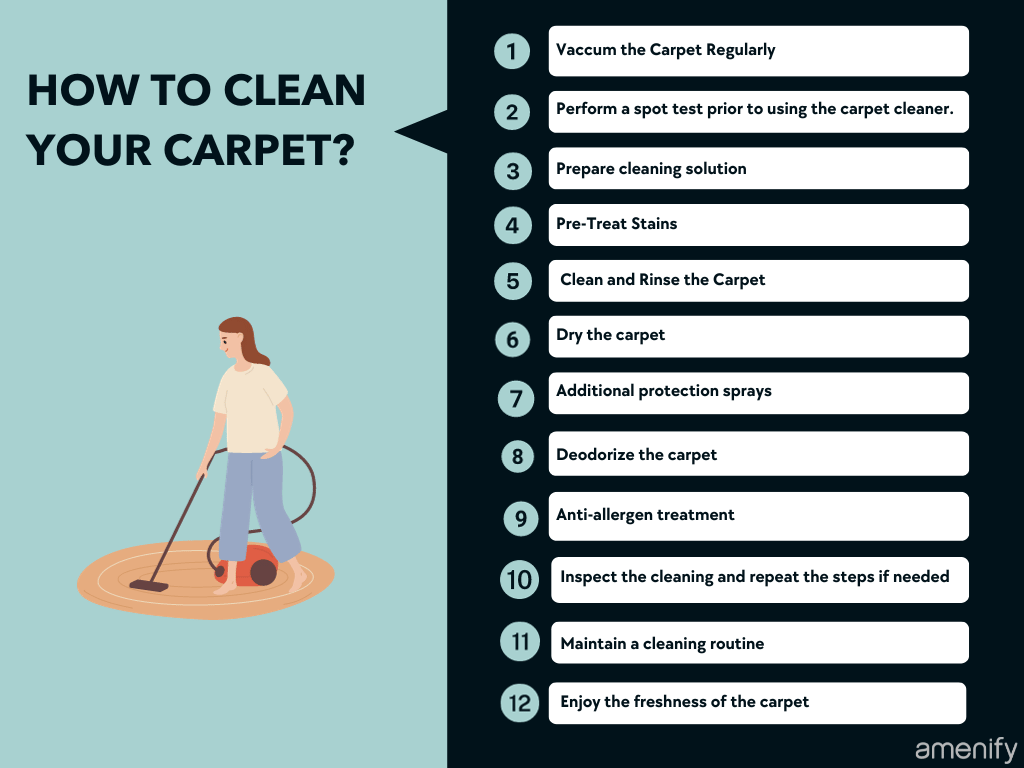How to Clean a Carpet: A Complete Guide
Do you know carpets are 4000 times dirtier than toilet seats? According to a study conducted by Home Advisor in 2021, it has been found that on an average carpet are 5.7 times more germs. How? Let’s learn here:
Your carpet functions as a major air filter in your home, capturing dust, dirt, pet dander, and more. Surprisingly, indoor air often contains double the dust found outdoors.
Even a small amount of carpet dust can host up to 2,000 dust mites, feeding on skin cells and residing in your carpet. Their residue mixes with dust and can become airborne, potentially triggering allergies.
Over time, your carpet can accumulate several pounds of soil beneath and within it. To maintain a healthier indoor environment, it is recommended vacuuming three times a week and deep cleaning carpets twice a year.
This makes us worry about our health, doesn't it? Cleaning carpets regularly is utmost essential due to the daily stress they face from foot traffic, spills, and pets. Therefore, we need to prevent staining and dust accumulation by cleaning them efficiently.
In this blog we will help you learn how to clean carpets and tips for retaining its color and freshness.
How Often Should You Clean Your Carpet?
The frequency with which you should clean your carpet depends on various factors such as foot traffic, presence of pets, dust allergies and individual lifestyle. Carpet manufacturers usually suggest a weekly surface cleaning and a thorough one every 12 to 18 months.
It also depends on what type of cleaning you are doing such as:
Vacuuming: At least once a week for low-traffic areas and two to three times a week for high-traffic areas.
Spot Cleaning: As needed, immediately after stains occur to prevent them from setting.
Deep Cleaning: At least once a year for low-traffic areas. For homes with children or pets, every 6 months is advisable.
Professional Cleaning: Recommended every 12–18 months, although homes with kids or pets may benefit from more frequent professional cleanings.
Ultimately, the specific cleaning schedule should align with your unique cleaning needs and preferences. Regular maintenance and prompt spot cleaning can also help extend the life of your carpet and keep it looking its best.
Materials and Tools You Will Need for Cleaning Your Carpet
To adequately clean your carpet, having the right materials and tools at your disposal is essential. Here's a list to guide you:
Carpet Cleaning Materials
Carpet Cleaning Solution
Stain Removers
Bucket
Clean Cloths
Cold Water
Carpet Cleaning Tools
Vacuum Cleaner
Steam Cleaner
Soft-Bristle Brush
Spray Bottle
Rubber Gloves
Fans or Air Movers (Optional)
Having these materials and tools prepared before you begin the cleaning process will make the task more efficient and effective.
How to Deep Clean a Carpet? 15 Steps Approach
Having a deep understanding of the carpet cleaning process can help in maintaining freshness and hygiene. Let's dive even deeper into each step:
Step #1: Vacuum the Carpet
Begin by vacuuming the entire area to remove surface-level dirt and debris. This initial vacuuming prepares the carpet for a deeper clean, ensuring that you're not just pushing dirt around when you use cleaning agents later on. Make sure to also vacuum the edges and corners of the room, where dust and dirt often accumulate. It's often helpful to go over the carpet several times from different directions to ensure that you're removing as much dirt as possible.
Expert Tip: Change the vacuum bag or empty the canister before starting for optimal suction power.
Step #2: Spot Test the Cleaning Solution
Before applying any cleaning agents to your carpet, conduct a spot test to make sure the solution won't damage or discolor the fabric. To do this, apply a small amount of your chosen cleaner to a hidden area of the carpet. Allow the solution to sit and then dry, noting any changes in the carpet's color or texture. This ensures that the cleaning process won't result in any unexpected damage.
Expert Tip: A white cloth will show any color leaching from the carpet, indicating that you should not proceed with that cleaning solution.
Step #3: Prepare the Cleaning Solution
Now, prepare your cleaning solution according to the manufacturer's instructions. Use a separate container specifically for this purpose, accurately measuring and diluting the solution. The correct dilution ensures that the cleaner will be effective without being too harsh on the carpet fibers. If you are using hot water extraction or a steam cleaner, this is when you'd fill the machine's reservoir.
Expert Tip: Mark your buckets or containers to prevent confusion.
Step #4: Pre-Treat Stains
Before you start the main cleaning process, apply a pre-treatment solution to any visible stains. Allow the solution to remain for a few minutes to dissolve the stain.This makes the stain easier to remove during the cleaning process. Remember, stubborn stains like oil or red wine may require specialized treatment products.
Expert Tip: Time is of the essence; the longer a stain is allowed to set, the harder it is to remove.
Step #5: Start Cleaning
For steam cleaning, fill your machine with water and the cleaning solution, then go over your carpet, following the manufacturer's instructions. The goal is to thoroughly wet the carpet without soaking it, allowing the cleaning solution to penetrate and lift dirt and stains. For manual cleaning, use a brush or cloth to apply the cleaning solution, scrubbing gently to remove dirt and stains.
Expert Tip: Ensure your steam cleaner is in proper working order beforehand to avoid any mid-cleaning hitches.
Also read, how to clean coffee maker?
Step #6: Rinse
Once the carpet has been cleaned, it needs to be rinsed to remove any leftover cleaning solution. This is important because any residual solution can attract dirt in the future. If you're using a steam cleaner, this usually involves running the machine over the carpet using only clean water. For manual cleaning, you may need to go over the area with a clean, damp cloth to remove any remaining cleaner.
Expert Tip: Use as little water as possible; excessive water can seep into the carpet pad, causing mold.
Step #7: Dry the Carpet
Drying the carpet quickly is essential to prevent the growth of mold and mildew. Use clean, dry towels to blot up as much moisture as possible. If you have fans or a wet-dry vacuum, these can also help speed up the drying process. In good weather, opening windows to let the room air out can also be beneficial.
Expert Tip: Lay down towels and walk over them to absorb excess moisture.
Step #8: Vacuum Again
Once the carpet is completely dry, vacuum it again to pick up any remaining dirt and to help lift the carpet fibers, making them look more plush and fresh. This second vacuuming ensures that any dirt loosened during the cleaning process is removed.
Expert Tip: Use a grooming rake to lift carpet fibers that have been flattened during the cleaning process.
Step #9: Additional Treatment
After the carpet is cleaned and dried, consider applying additional treatments like Scotchgard to protect against future stains or an enzyme cleaner to break down pet odors. This extra layer of protection can help keep your carpet cleaner for longer.
Expert Tip: Don’t rush through the application; ensure even coverage.
Step #10: Deodorize the Carpet
For a finishing touch, apply a carpet deodorizer or simply sprinkle some baking soda over the carpet. Allow it to sit for at least 30 minutes to absorb lingering odors, then vacuum it up. This leaves your carpet smelling fresh.
Expert Tip: If using baking soda, let it sit for at least 30 minutes before vacuuming.
Also read, how to clean shower head?
Step #11: Apply Anti-Allergen Treatment
To make your home as healthy as possible, consider applying an anti-allergen treatment to your freshly cleaned carpet. These treatments can neutralize common allergens like pet dander, pollen, and dust mites, making your home more comfortable for allergy sufferers.
Expert Tip: Look for treatments that are non-toxic and safe for children and pets.
Step #12: Check Furniture
Before moving furniture back onto the carpet, make sure there are no wet spots left that could cause water marks or rust stains from metal furniture legs. Also, check to make sure there has been no color transfer from the furniture to the carpet.
Expert Tip: Wait until the carpet is completely dry before replacing furniture.
Step #13: Final Inspection
Once everything is done, conduct a final inspection to make sure you haven't missed any spots and that all stains have been adequately treated. Make sure you're satisfied with the appearance and smell of the carpet, treating any areas that need additional cleaning.
Expert Tip: Use natural light for the inspection, as it’s the best to spot any remaining stains or issues.
Step #14: Establish a Maintenance Schedule
After the deep cleaning is complete, think about how you can extend the life of your carpet. Regular vacuuming, prompt treatment of spills, and periodic deep cleaning can keep your carpet looking its best for years to come.
Expert Tip: High-traffic areas may need more frequent cleaning or preventative measures like rugs or runners.
Also read, Difference between cleaning, sanitizing and disinfecting
Step #15: Enjoy Your Clean Carpet!
Now that the hard work is done, it's time to enjoy your fresh, clean carpet. A clean carpet not only enhances the look of your home, but it also creates a healthier living environment by removing dirt, dust, and allergens.
Expert Tip: Consider rearranging furniture occasionally to even out wear and tear on your carpet.
By incorporating these steps into your carpet cleaning routine, you can achieve a deeper clean and a healthier living environment. These practices not only enhance the appearance and lifespan of your carpet but also contribute to your home's overall cleanliness and your family's well-being.
Tips to Keep Carpet Clean For a Long-Term
To ensure that your carpet remains clean for an extended period after a deep clean, consider the following best practices:
Frequent Vacuuming: Make it a habit to vacuum your carpet at least once a week. For high-traffic areas, consider vacuuming more frequently.
Use Quality Door Mats: Placing mats at each entrance can significantly reduce the amount of dirt and debris that gets onto your carpet.
Immediate Spot Cleaning: Act quickly to treat spills and stains. The sooner you clean them up, the less likely they are to set in.
Invest in a Carpet Protector: A quality carpet protector can repel stains and extend the time between professional cleanings.
Rotate Furniture: Periodically rearranging furniture can prevent wear patterns from forming on your carpet, making it look cleaner longer.
Remove Shoes: Implement a no-shoe policy in carpeted areas to minimize the amount of dirt and debris that gets tracked in.
Use Area Rugs: In high-traffic zones, use area rugs or runners to protect the underlying carpet. Just make sure to clean these rugs regularly as well.
Also follow deep cleaning checklist
Steam Clean Quarterly: Make sure to schedule a thorough steam cleaning for your carpet every three to six months. This will effectively eliminate any stubborn dirt and invigorate the fibers, giving your carpet a much-needed revival.
Pet Care: If you have pets, groom them regularly to reduce shedding and consider placing a mat under food and water bowls to catch spills.
Anti-Static Sprays: Use anti-static sprays if you find that your carpet attracts a lot of dust. This not only keeps the carpet cleaner but also improves the indoor air quality.
Use Quality Cleaning Supplies: Always opt for high-quality, carpet-safe cleaning solutions and equipment. Cheaper products may harm the fabric and color of your carpet in the long run.
Professional Cleaning: Even with meticulous at-home care, consider getting your carpet professionally cleaned at least once a year. They have the tools and expertise to remove stains and dirt that regular cleaning can't.
Around 70-80% of households in the United States feature carpet flooring, underscoring the extensive adoption of carpets in American homes.
Air Purifiers: Use air purifiers in rooms with carpets to reduce airborne dust particles that might settle on the carpet surface.
Regular Inspection: Periodically check your carpet for any signs of mold, especially in humid climates or after any water damage. Early detection can prevent larger issues.
Dry Quickly: If your carpet does get wet, ensure it dries completely as quickly as possible to prevent mold growth. Accelerate the process by utilizing fans or a dehumidifier.
By incorporating these steps into your daily routine, you can considerably prolong the intervals between deep cleaning sessions, ultimately saving valuable time and money.
How Amenify can Help You Clean Your Carpet?
We recognize at Amenify that maintaining a clean home is not just about cleanliness, but also about the inner tranquility it brings. We are proud to serve over 2 million households in more than 900 cities, providing extensive lifestyle services that have earned us a remarkable 50,000 five-star reviews. With Amenify's services you can enjoy cleaner and longer-lasting carpets, ensuring your investment in both aesthetics and comfort remains in top condition. We are dedicated to delivering excellence, dependability, and professionalism. Our team of experts undergoes rigorous vetting and training to guarantee your home receives the highest level of care it deserves.
FAQs on Carpet Cleaning
-
To clean a carpet all by yourself, combine one part white vinegar with three parts water in a bowl or small container. Dip the scrub brush bristles into the mixture and gently work it into the carpet, massaging the fibers without over-saturating. Finish by using a cloth to blot any excess moisture.
-
The most effective method for cleaning a carpet is to wash it using a conventional yet highly efficient approach that involves the use of cleaning powder. Just sprinkle it onto the carpet, let it sit overnight, and then vacuum it up the next morning. Baking soda, used similarly, is equally effective. Additionally, it's particularly adept at removing pet hair from carpets.
-
Yes, baking soda can effectively clean carpets. When sprinkled and left to sit, it absorbs odors and helps break down stains. It's especially useful for pet odors and can also assist in lifting pet hair from carpets. However, for deep cleaning, consider using a carpet cleaner or professional service.
-
Yes, it's possible to clean a carpet by hand. You can spot-treat stains, scrub with a mixture of mild detergent and water, and use a brush or cloth to clean small areas. However, for a thorough deep cleaning, a carpet cleaning machine or professional service is recommended for better results.





